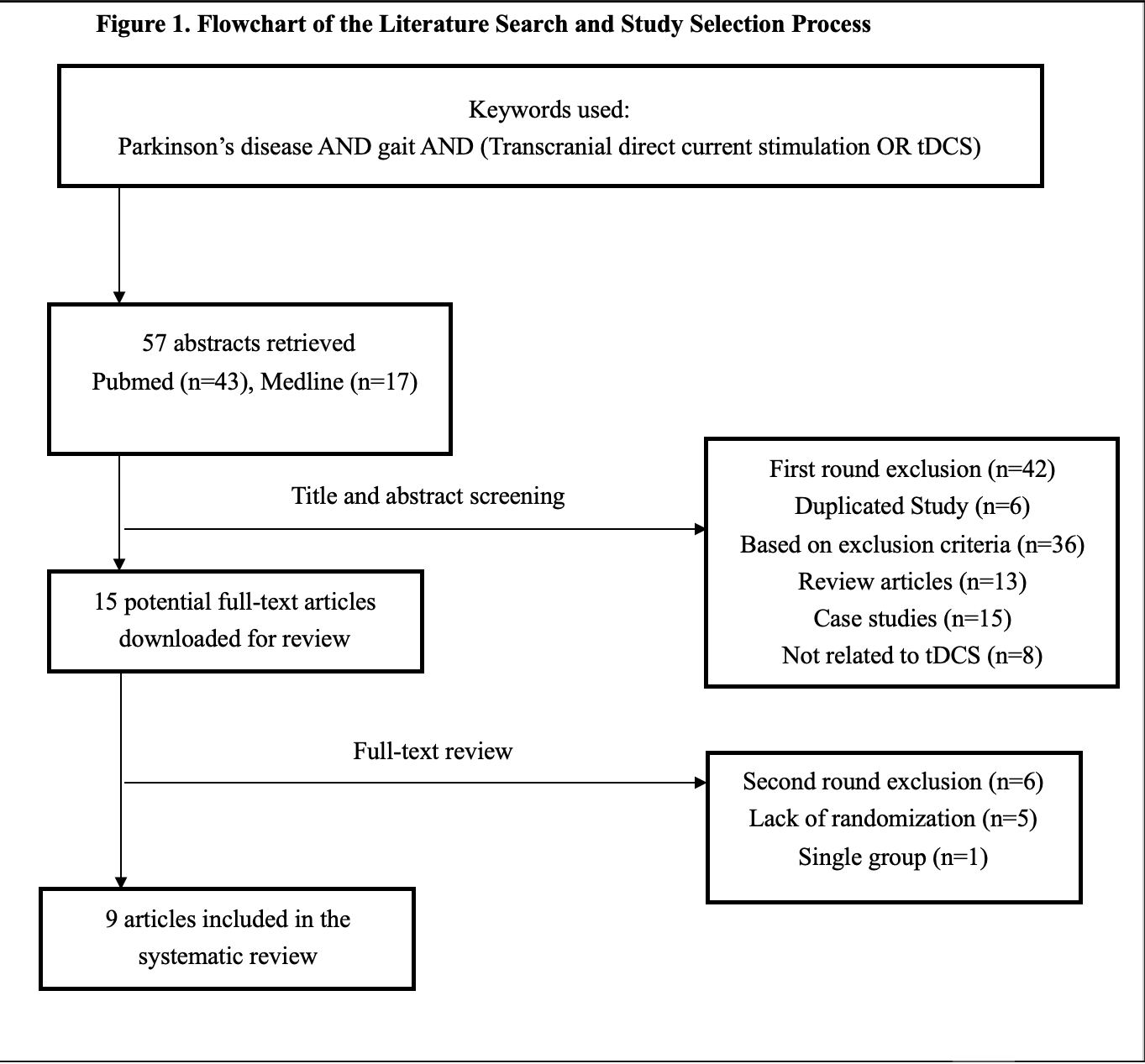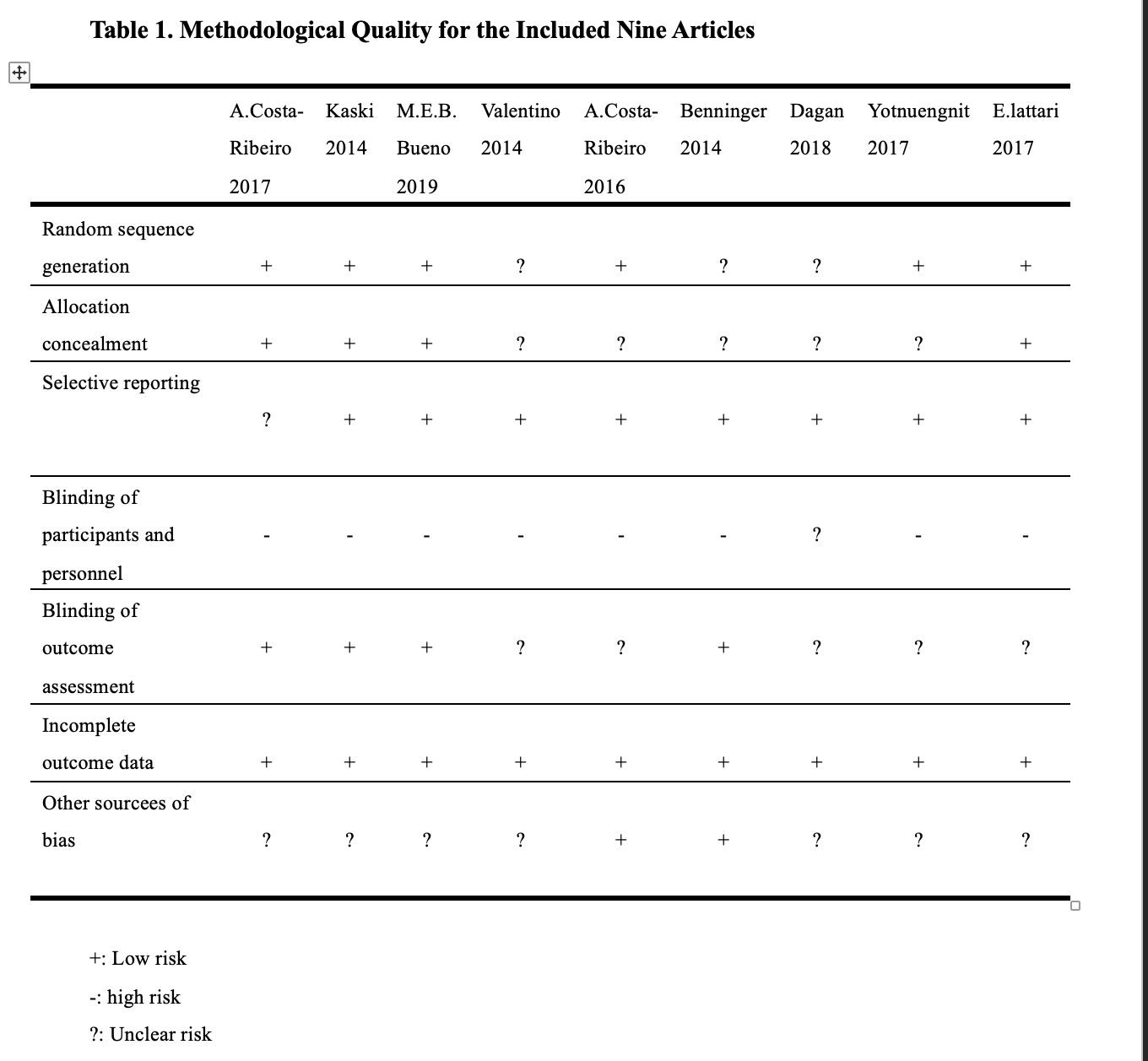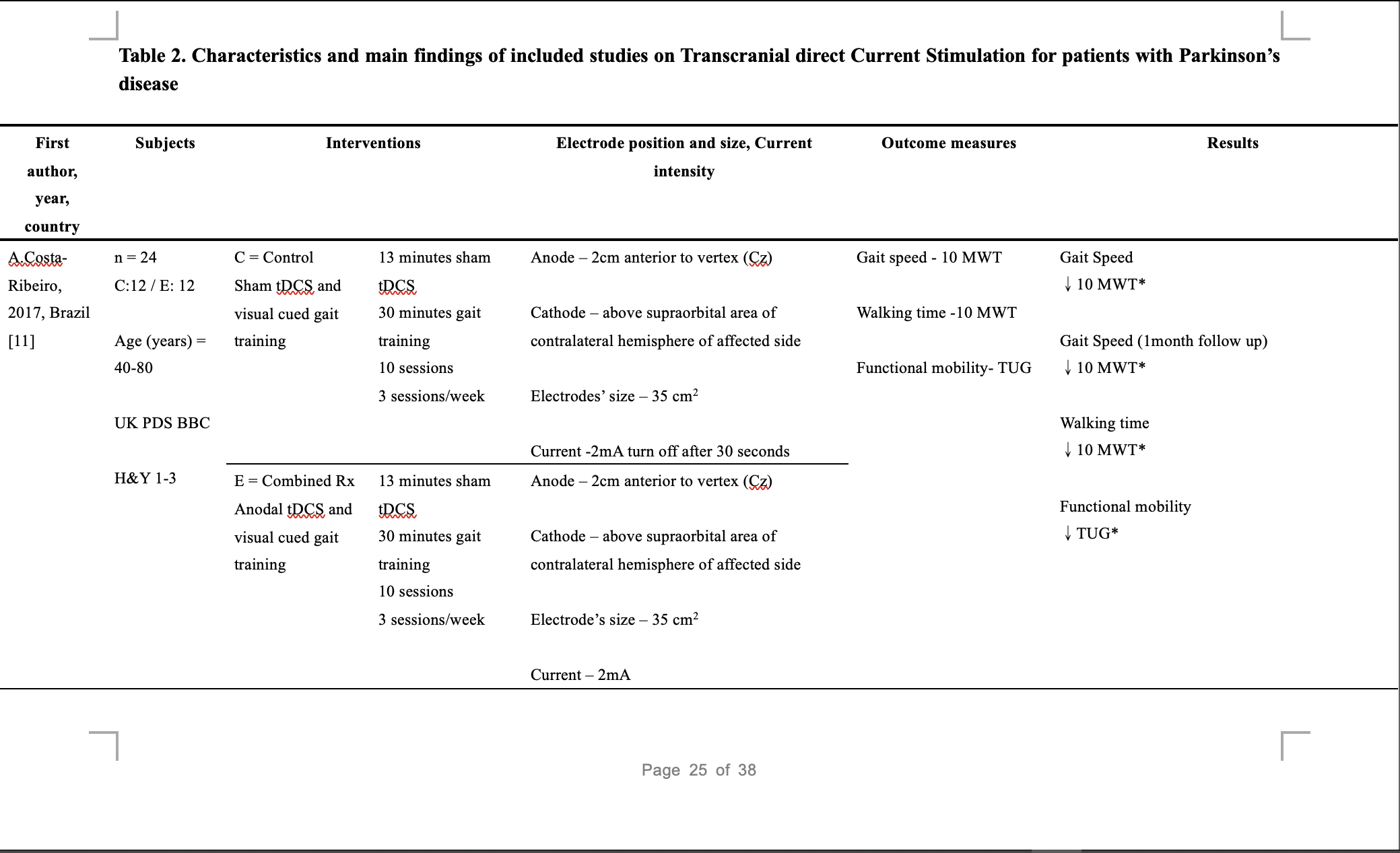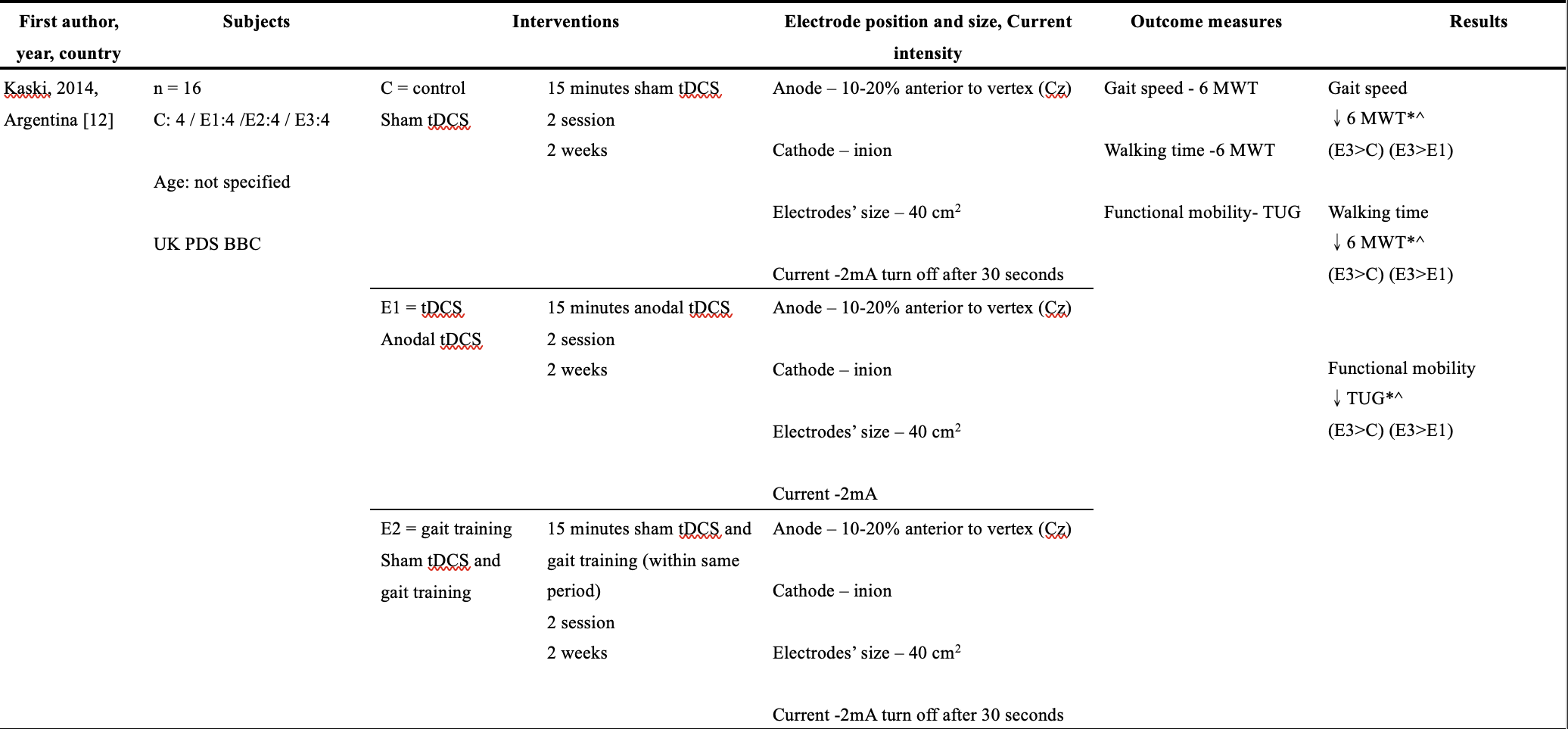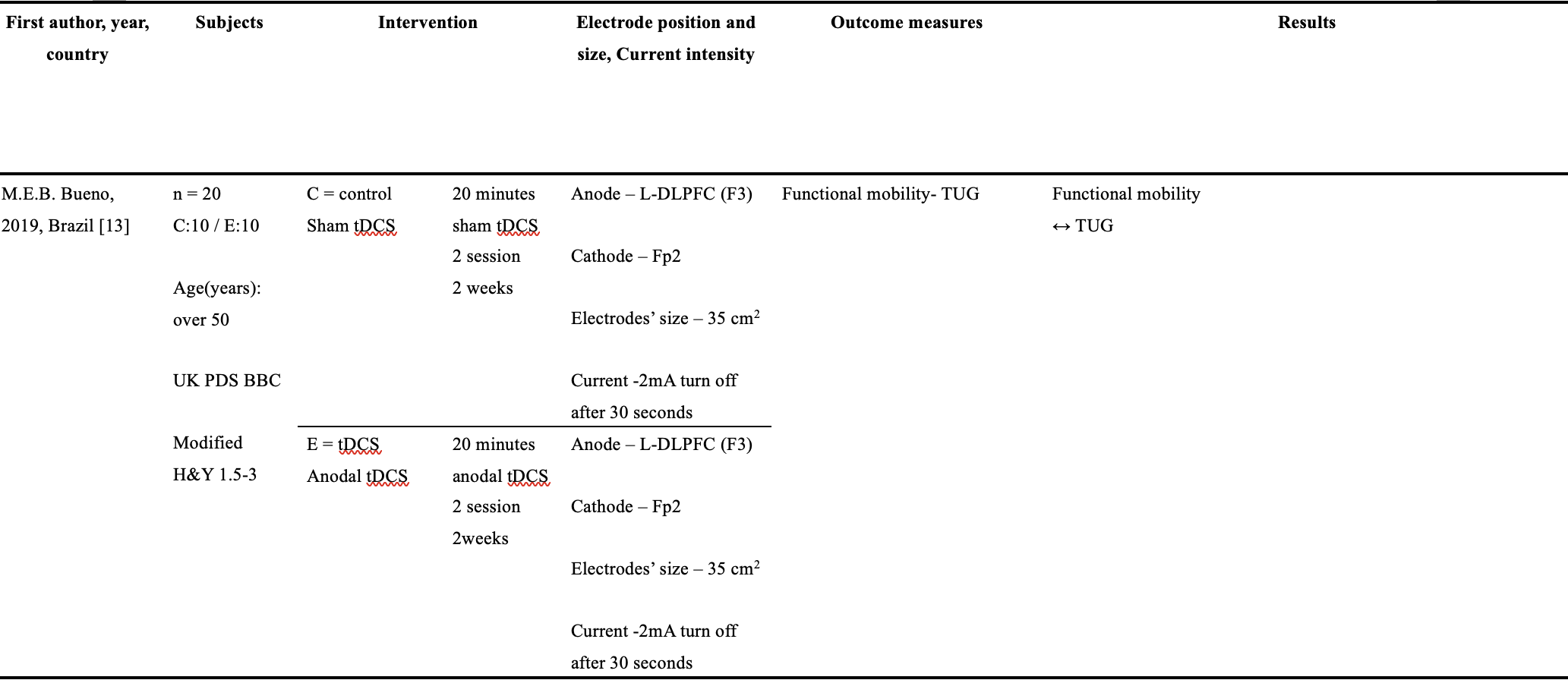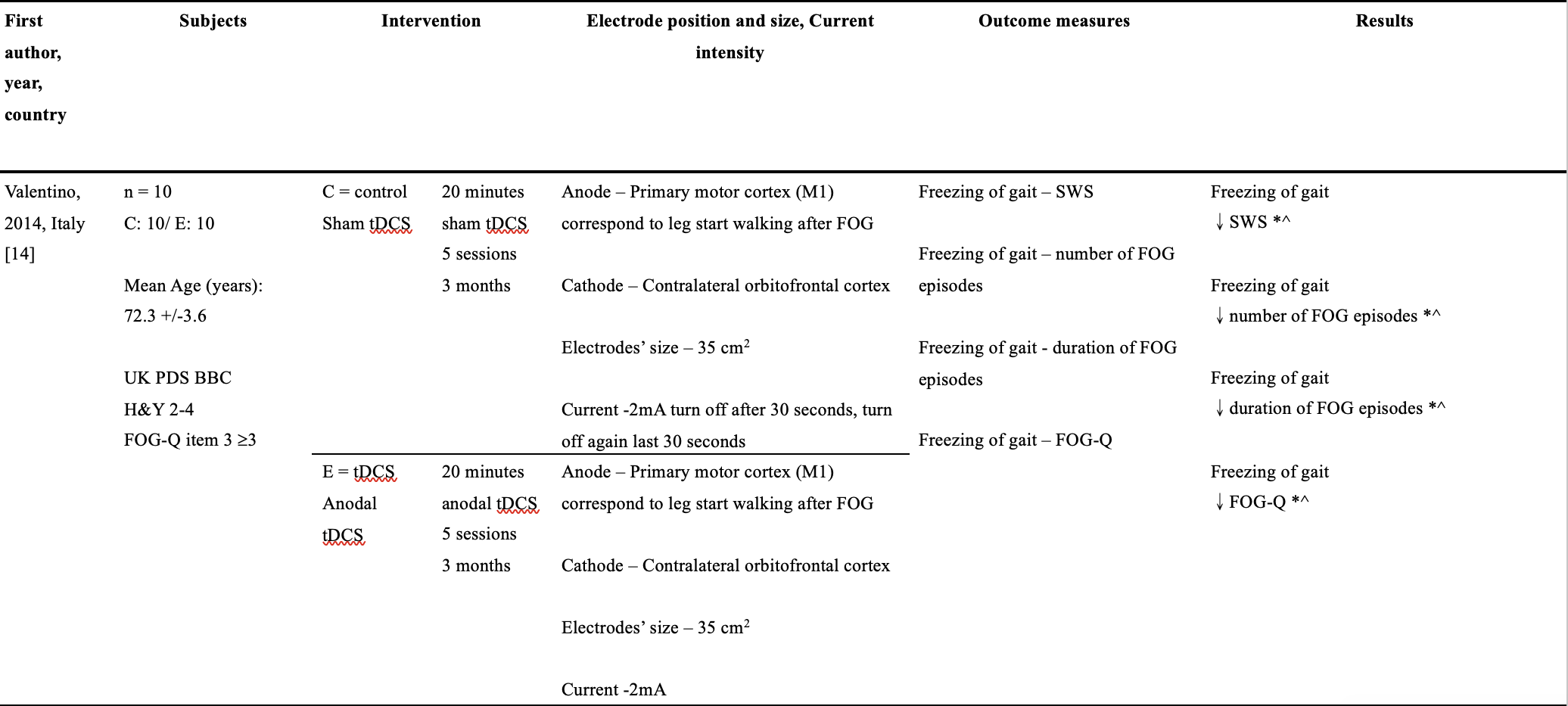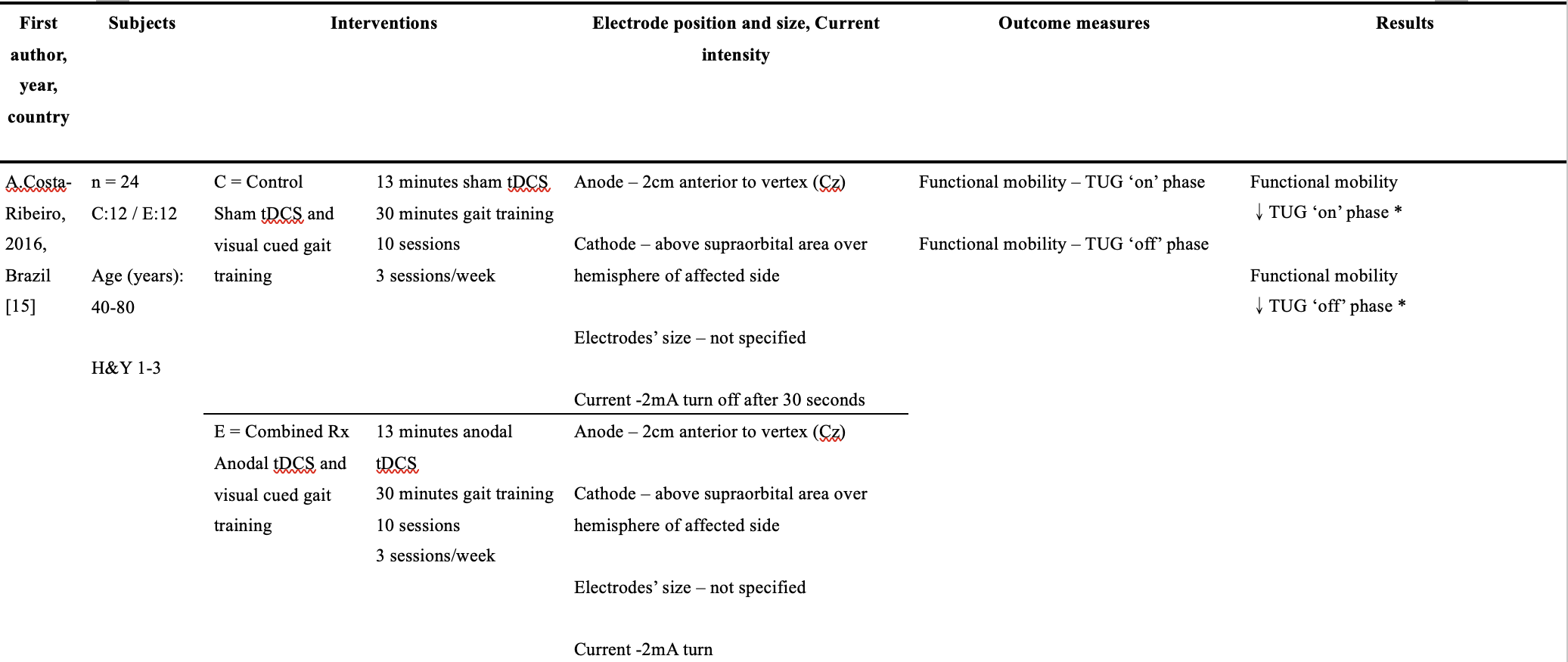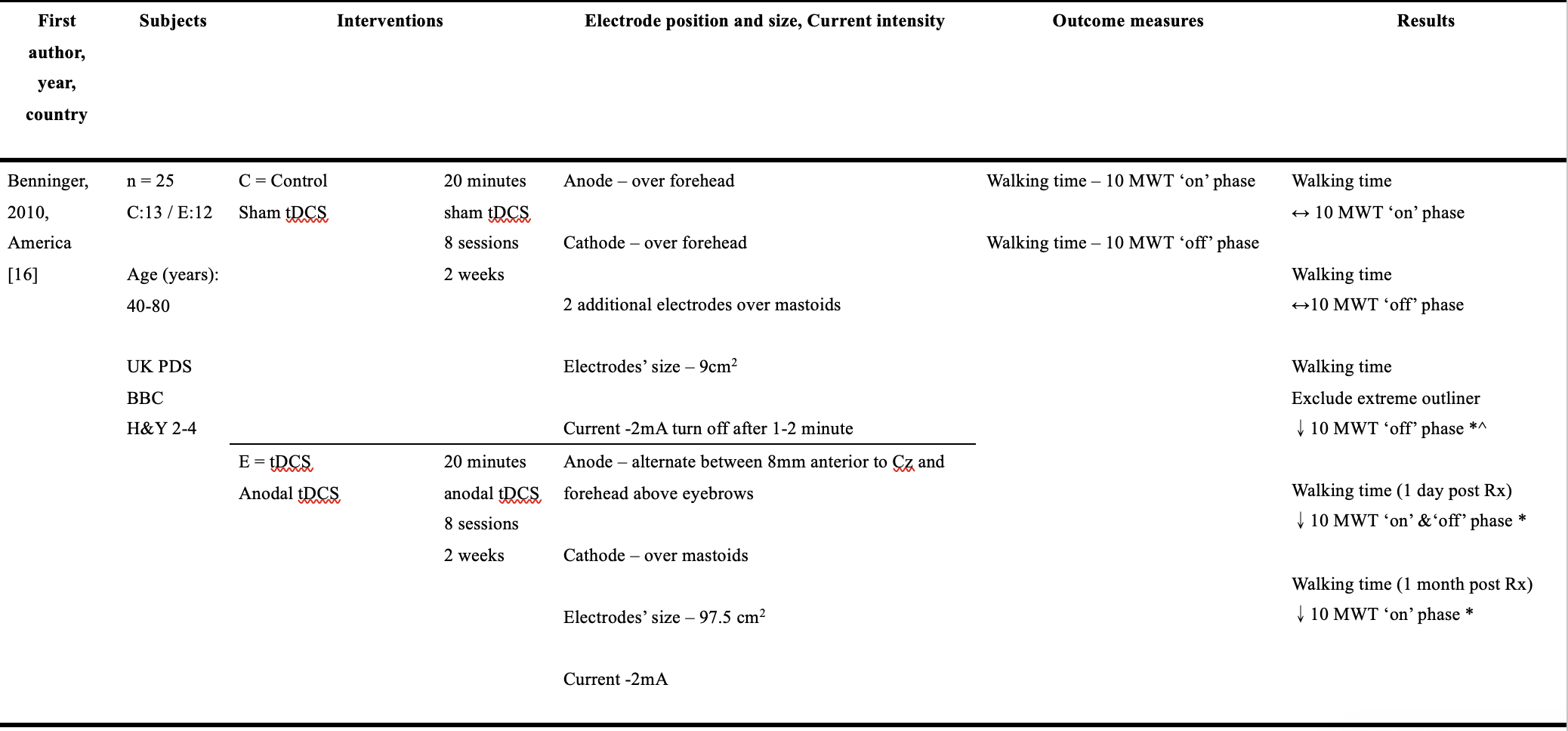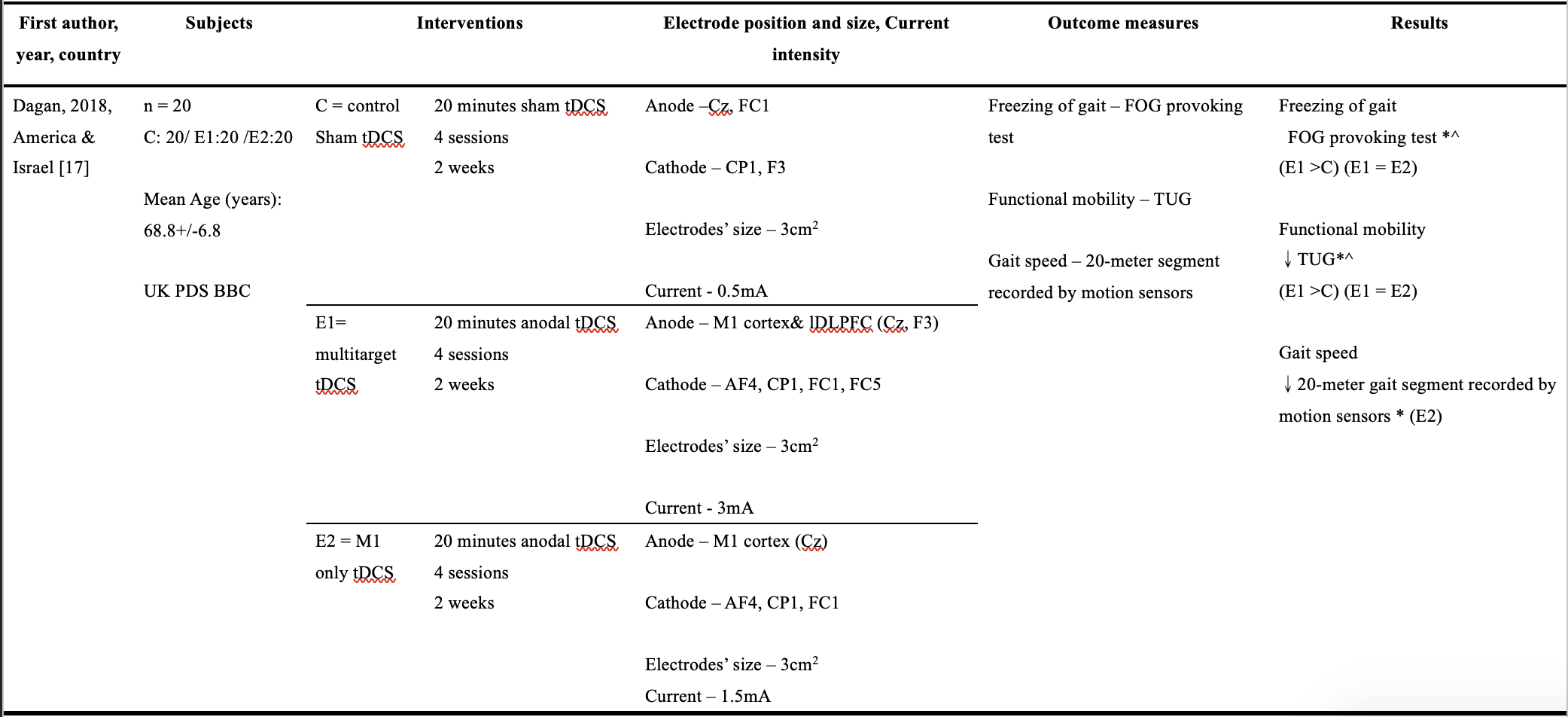Category: Parkinsonism, Others
Objective: The objective of this review is to update evidence on benefits of tDCS on gait speed and freezing of gait (FOG) for PD patients
Background: Parkinson’s disease (PD) is one of the most well-known neurological disease, characterized by degenerative brain changes in substantia nigra with formation of abnormal proteins called Lewy bodies. The common clinical signs include bradykinesia, 4-6 Hz resting tremor, muscular rigidity and postural instability. Transcranial direct current stimulation (tDCS) was being explored to act as substitute intervention to reduce motor complications in PD patients. However, results from recent reviews varied between possibly short-term motor outcome improvements with insufficient evidence to determine the effects of tDCS.
Method: Relevant randomized controlled trials (RCTs) were collected via searching on Online Literature Databases (MEDLINE & PubMed). Keywords of ”Parkinson’s disease”, ”Transcranial Direct Current Stimulation”, ”tDCS”, and ”gait” were used in research strategy. Only RCTs published between 2010-2020 and written in English were included. The included articles were assessed with ‘Risk of bias’ tool presented in Cochrane Handbook for Systematic Reviews of Interventions.
Results: Nine RCTs involved a total of 209 participants. Outcome measures being assessed included: gait speed, walking time, functional mobility, and freezing of gait.
Conclusion: Current evidence supports tDCS with short term benefits on improving gait speed and FOG in PD patients. Combining tDCS with gait training are related to prolonged benefits in gait outcomes. Long term effectiveness of tDCS remain inconclusive due to lack of long term follow up.
References: [1] Dickson, Dennis W. “Neuropathology of Parkinson Disease.” Parkinsonism & Related Disorders 46.Suppl 1 (2018): S30-33. Web.
[2] Opara, Józef, Małecki, Andrzej, Małecka, Elżbieta, and Socha, Teresa. “Motor Assessment in Parkinson`s Disease.” Annals of Agricultural and Environmental Medicine 24.3 (2017): 411-15. Web.
[3] Sveinbjornsdottir, Sigurlaug. “The Clinical Symptoms of Parkinson’s Disease.” Journal of Neurochemistry 139.S1 (2016): 318-24. Web.
[4] Tahtis, Vassilios, and Kaski, Diego. “Parkinson’s Disease Treatments: Focus on Transcranial Direct Current Stimulation (tDCS).” Journal of Parkinsonism & Restless Legs Syndrome 7 (2017): 55-70. Web.
[5] Schoellmann, Anna, Scholten, Marlieke, Wasserka, Barbara, Govindan, Rathinaswamy B, Krüger, Rejko, Gharabaghi, Alireza, Plewnia, Christian, and Weiss, Daniel. “Anodal TDCS Modulates Cortical Activity and Synchronization in Parkinson’s Disease Depending on Motor Processing.” NeuroImage Clinical 22 (2019): 101689. Web.
[6] Ishikuro, Koji, Dougu, Nobuhiro, Nukui, Takamasa, Yamamoto, Mamoru, Nakatsuji, Yuji, Kuroda, Satoshi, Matsushita, Isao, Nishimaru, Hiroshi, Araujo, Mariana F P, and Nishijo, Hisao. “Effects of Transcranial Direct Current Stimulation (tDCS) Over the Frontal Polar Area on Motor and Executive Functions in Parkinson’s Disease; A Pilot Study.” Frontiers in Aging Neuroscience 10 (2018): 231. Web.
[7] Lee, Hyo Keun, Ahn, Se Ji, Shin, Yang Mi, Kang, Nyeonju, and Cauraugh, James H. “Does Transcranial Direct Current Stimulation Improve Functional Locomotion in People with Parkinson’s Disease? A Systematic Review and Meta-analysis.” Journal of Neuroengineering and Rehabilitation 16.1 (2019): 84. Web.
[8] Simpson, Michael William, and Mak, Margaret. “The Effect of Transcranial Direct Current Stimulation on Upper Limb Motor Performance in Parkinson’s Disease: A Systematic Review.” Journal of Neurology 267.12 (2019): 3479-488. Web.
[9] Elsner B, Kugler J, Pohl M, Mehrholz J. Transcranial direct current stimulation (tDCS) for idiopathic Parkinson’s disease . Cochrane Database of Systematic Reviews 2016, Issue 7. Art. No.: CD010916. DOI: 10.1002/14651858.CD010916.pub2.
[10] Higgins JPT, Altman DG, Sterne JAC (editors). Chapter 8: Assessing risk of bias in included studies. In: Higgins JPT, Churchill R, Chandler J, Cumpston MS (editors), Cochrane Handbook for Systematic Reviews of Interventions version 5.2.0 (updated June 2017), Cochrane, 2017. Available from www.training.cochrane.org/handbook.
[11] Costa-Ribeiro, Adriana, Maux, Ariadne, Bosford, Thamyris, Aoki, Yumi, Castro, Rebeca, Baltar, Adriana, Shirahige, Lívia, Moura Filho, Alberto, Nitsche, Michael A, and Monte-Silva, Kátia. “Transcranial Direct Current Stimulation Associated with Gait Training in Parkinson’s Disease: A Pilot Randomized Clinical Trial.” Developmental Neurorehabilitation 20.3 (2017): 121-28. Web.
[12] Kaski, D, Dominguez, RO, Allum, JH, Islam, AF, and Bronstein, AM. “Combining Physical Training with Transcranial Direct Current Stimulation to Improve Gait in Parkinson’s Disease: A Pilot Randomized Controlled Study.” Clinical Rehabilitation 28.11 (2014): 1115-124. Web.
[13] Bueno, Maria Eduarda Brandão, Do Nascimento Neto, Luiz Inácio, Terra, Marcelle Brandão, Barboza, Natália Mariano, Okano, Alexandre Hideki, and Smaili, Suhaila Mahmoud. “Effectiveness of Acute Transcranial Direct Current Stimulation on Non-motor and Motor Symptoms in Parkinson’s Disease.” Neuroscience Letters 696 (2019): 46-51. Web.
[14] Valentino, Francesca, Cosentino, Giuseppe, Brighina, Filippo, Pozzi, Nicolò Gabriele, Sandrini, Giorgio, Fierro, Brigida, Savettieri, Giovanni, D’Amelio, Marco, and Pacchetti, Claudio. “Transcranial Direct Current Stimulation for Treatment of Freezing of Gait: A Cross‐over Study.” Movement Disorders 29.8 (2014): 1064-069. Web
[15] Costa-Ribeiro, Adriana, Maux, Ariadne, Bosford, Thamyris, Tenório, Yumi, Marques, Déborah, Carneiro, Maíra, Nitsche, Michael A, Filho, Alberto Moura, and Monte-Silva, Kátia. “Dopamine-independent Effects of Combining Transcranial Direct Current Stimulation with Cued Gait Training on Cortical Excitability and Functional Mobility in Parkinson’s Disease.” Journal of Rehabilitation Medicine 48.9 (2016): 819-23. Web.
[16] Benninger, David H, Lomarev, Mikhail, Lopez, Grisel, Wassermann, Eric M, Li, Xiaobai, Considine, Elaine, and Hallett, Mark. “Transcranial Direct Current Stimulation for the Treatment of Parkinson’s Disease.” Journal of Neurology, Neurosurgery and Psychiatry 81.10 (2010): 1105-111. Web.
[17] Dagan, Moria, Herman, Talia, Harrison, Rachel, Zhou, Junhong, Giladi, Nir, Ruffini, Giulio, Manor, Brad, and Hausdorff, Jeffrey M. “Multitarget Transcranial Direct Current Stimulation for Freezing of Gait in Parkinson’s Disease.” Movement Disorders 33.4 (2018): 642-46. Web.
[18] Yotnuengnit, Pattarapol, Bhidayasiri, Roongroj, Donkhan, Rattana, Chaluaysrimuang, Juthamas, and Piravej, Krisna. “Effects of Transcranial Direct Current Stimulation Plus Physical Therapy on Gait in Patients With Parkinson Disease: A Randomized Controlled Trial.” American Journal of Physical Medicine & Rehabilitation 97.1 (2018): 7-15. Web.
[19] Lattari, Eduardo, Costa, Samara Sezana, Campos, Carlos, De Oliveira, Aldair José, Machado, Sérgio, and Maranhao Neto, Geraldo Albuquerque. “Can Transcranial Direct Current Stimulation on the Dorsolateral Prefrontal Cortex Improves Balance and Functional Mobility in Parkinson’s Disease?” Neuroscience Letters 636 (2017): 165-69. Web.
[20] Rogers, Gabriel, Davies, Debbie, Pink, Joshua, and Cooper, Paul. “Parkinson’s Disease: Summary of Updated NICE Guidance.” BMJ 358 (2017): J1951. Web.
To cite this abstract in AMA style:
T. Mok. A Literature Review: Effectiveness of Transcranial Direct Current Stimulation on gait speed and freezing of gait in patients with Parkinson’s disease [abstract]. Mov Disord. 2022; 37 (suppl 2). https://www.mdsabstracts.org/abstract/a-literature-review-effectiveness-of-transcranial-direct-current-stimulation-on-gait-speed-and-freezing-of-gait-in-patients-with-parkinsons-disease/. Accessed April 1, 2025.« Back to 2022 International Congress
MDS Abstracts - https://www.mdsabstracts.org/abstract/a-literature-review-effectiveness-of-transcranial-direct-current-stimulation-on-gait-speed-and-freezing-of-gait-in-patients-with-parkinsons-disease/

